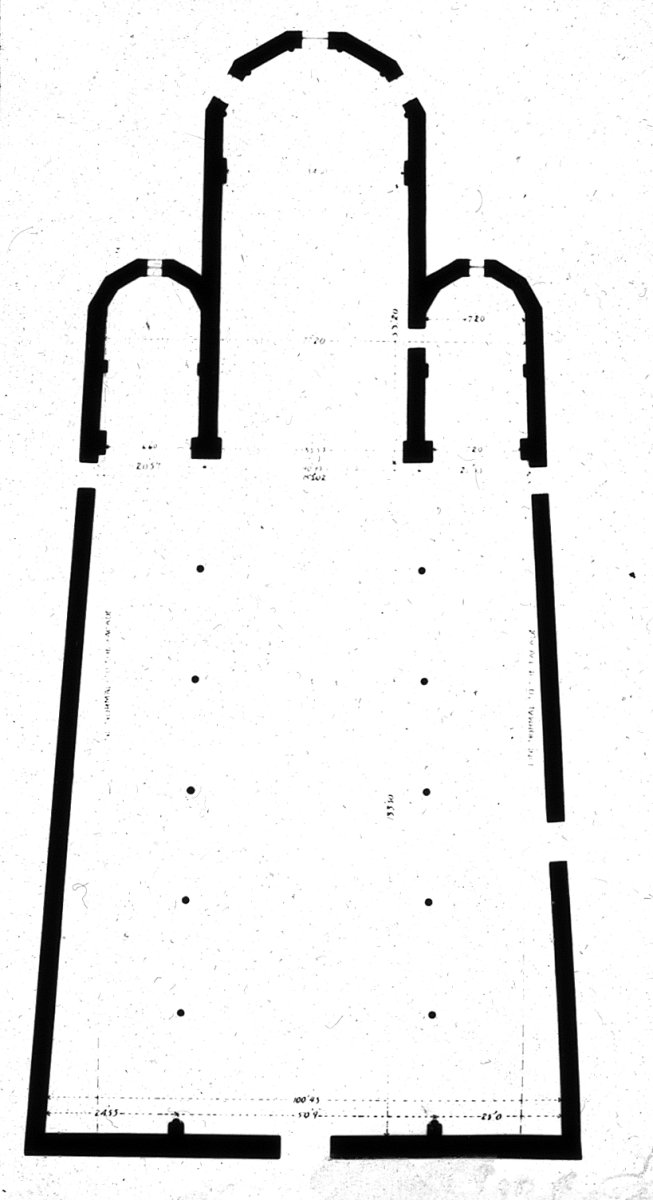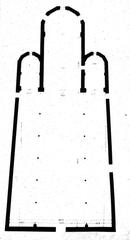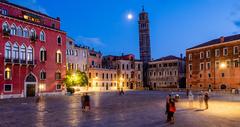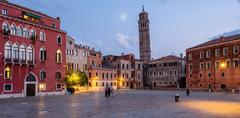
Santo Stefano Venice: Visiting Hours, Tickets, and Historical Site Guide
Date: 14/06/2025
Introduction
Nestled in the bustling San Marco district, the Church of Santo Stefano stands as a striking embodiment of Venice’s religious, artistic, and architectural heritage. Renowned for its Venetian Flamboyant Gothic architecture—most notably the intricately carved marble portal by Bartolomeo Bon and its unique keel-shaped wooden ceiling—Santo Stefano offers a captivating journey into the heart of Venetian history. Founded in the 13th century by Augustinian Hermits, it houses masterpieces by artists like Jacopo Tintoretto and Bartolomeo Vivarini, as well as significant sculptures by the Lombardo family and Antonio Canova (meetingvenice.it, venicevisitpass.com, lovevenice.net, venice-travel-guide.com).
This guide provides comprehensive information for visitors, including opening hours, ticketing, accessibility, architectural and artistic highlights, travel tips, and nearby attractions—ensuring you can plan a rewarding visit to this Venetian gem.
Table of Contents
- Practical Information
- History and Architecture
- Artistic Highlights
- Visitor Experience and Tips
- Nearby Attractions
- Frequently Asked Questions (FAQ)
- Conclusion and Call to Action
- References and Further Reading
Practical Information
Visiting Hours
Santo Stefano is generally open to visitors Tuesday through Sunday, 10:00 AM to 5:00 PM. It is closed on Mondays and major public holidays. Hours may vary for religious services or special events—always check the official Venice tourism website or local signage before your visit (venicetraveltips.com).
Tickets and Admission
- Admission: Free of charge; donations are encouraged to support preservation.
- Guided Tours: Available for a fee via local tour operators or online platforms. Booking in advance is recommended for deeper insights into the church’s history and art.
How to Get There
- By Foot: A 7–10 minute walk from Piazza San Marco through Venice’s picturesque streets.
- By Vaporetto: Nearest stops are “San Samuele,” “Sant’Angelo,” and “Accademia.” All are within a short walk of the church.
- By Campo: Located in the lively Campo Santo Stefano, a central hub for both locals and visitors.
Accessibility
- The campo (square) is flat and generally wheelchair-friendly.
- The church features a few shallow steps at the entrance; interior flooring may be uneven.
- Wheelchair access is limited—contact local tourist offices for specific assistance or accommodations (chorusvenezia.org).
History and Architecture
Origins and Evolution
Founded in the 13th century by the Augustinian Hermits, Santo Stefano began as a modest Gothic church strategically positioned near Venice’s political and commercial heart. Its prominence grew alongside Venice’s own expansion, and between the late 14th and 15th centuries, the church underwent major reconstruction, adopting the Flamboyant Gothic style and expanding its architectural footprint (Spotting History).
Architectural Features
- Façade & Marble Portal: The fourteenth-century brick façade is punctuated by a richly decorated marble portal (1438–1442) by Bartolomeo Bon (bonjourvenise.fr). The portal’s elaborate tracery and Gothic ornamentation exemplify Venetian stonework mastery, while the relatively austere façade reflects a balance between grandeur and local environmental constraints.
- Bell Tower (Campanile): Predating the current church, the campanile features a three-arched belfry chamber crowned by an octagonal drum, making it a distinctive landmark in the district (bonjourvenise.fr).
- Spatial Layout: The interior consists of three naves separated by slender columns, lacking transepts and thus creating a spacious, uninterrupted nave. The main nave, over 90 meters long, is among the largest in Venetian monastic churches (lovevenice.net).
- Keel-Shaped Wooden Ceiling: The nave’s ceiling, shaped like an inverted ship’s hull, is a technical and symbolic marvel, referencing Venice’s maritime heritage. Adorned with painted rosettes, it enhances the church’s verticality and acoustics (meetingvenice.it).
- Cloister and Extensions: The church features an unusual extension built over the Rio del Santissimo canal, connected by a bridge and housing the apses—a testament to Venetian ingenuity in working with limited urban space (venice-travel-guide.com).
Notable Details
- Marble Portal: With intricate religious iconography and foliage motifs, it is a highlight of Venetian Gothic sculpture.
- Choir Stalls: Finely inlaid woodwork, dating from 1488, represent Renaissance craftsmanship.
- Funerary Monuments: Includes Antonio Canova’s neoclassical stele for Senator Giovanni Falier and the tomb of Giacomo Surian by Pietro Lombardo.
- Decorative Frescoes: Walls patterned with rhomboids and crosses in trompe l’oeil brick add warmth and visual interest.
Artistic Highlights
Santo Stefano is a repository of Renaissance artworks and sculptures:
- Tintoretto: Three monumental canvases—The Last Supper, Christ Washing the Apostles’ Feet, and Christ in the Garden of Gethsemane—adorn the sacristy (lovevenice.net).
- Bartolomeo Vivarini: Polyptychs and paintings such as Saint Nicola from Bari and Saint Lawrence.
- Bonifacio de’ Pitati: Renowned for evocative religious scenes.
- Paolo Veneziano: A Crucifix illustrating the transition from Byzantine to Venetian Gothic.
- Paris Bordon, Giuseppe Angeli, Gaspare Diziani: Various works further enrich the church’s collection.
- Tullio and Pietro Lombardo: Marble sculptures exemplifying Renaissance virtuosity.
- Antonio Canova: The funerary stele of Senator Giovanni Falier, a masterpiece of neoclassical sculpture (venicevisitpass.com).
The sacristy is often described as a “museum within the church,” housing some of Venice’s most important Renaissance art.
Visitor Experience and Tips
- Dress Code: Modest attire is required—cover shoulders and knees, remove hats.
- Photography: Permitted without flash or tripods. Some areas (e.g., sacristy) may have restrictions.
- Quiet Reflection: The church remains an active place of worship; maintain silence, especially during services.
- Best Times to Visit: Early morning or late afternoon for fewer crowds. Off-peak seasons (November–March) offer a more tranquil experience.
- Facilities: Restrooms are available in the square. Local cafés and shops offer refreshments and souvenirs.
Nearby Attractions
- Campo Santo Stefano: One of Venice’s largest and liveliest squares, hosting markets, festivals (notably Christmas markets), and outdoor cafés (Venice Travel Tips).
- Accademia Gallery: Masterpieces of Venetian art, just a short walk away.
- Teatro La Fenice: The famed opera house offers tours and performances.
- Palazzo Cavalli-Franchetti: A Gothic palace overlooking the Grand Canal, often hosting exhibitions.
- Peggy Guggenheim Collection and St. Mark’s Basilica: Both within easy walking distance, enriching your cultural itinerary.
Frequently Asked Questions (FAQ)
Q: What are Santo Stefano’s opening hours?
A: Usually open Tuesday–Sunday, 10:00 AM–5:00 PM. Hours may vary for holidays or events.
Q: Is there an entry fee or ticket required?
A: Entry is generally free, but donations are encouraged. Special events may require tickets.
Q: Are guided tours available?
A: Yes, through local operators or online booking platforms.
Q: Is the church wheelchair accessible?
A: The campo is flat, but the church has steps and uneven floors. Accessibility is limited; contact the tourist office for assistance.
Q: Can I take photographs inside?
A: Photography is permitted without flash or tripods; always check posted guidelines.
Q: How do I get there by public transport?
A: The nearest vaporetto stops are San Samuele, Sant’Angelo, and Accademia.
Conclusion and Call to Action
Santo Stefano Church is a standout among Venice’s historical sites, uniting Gothic architectural grandeur with a treasury of Renaissance art and sculpture. Its central location in Campo Santo Stefano and accessibility by both foot and vaporetto make it an ideal stop for your Venetian adventure. To fully appreciate its history and artistry, consider a guided tour, check current visiting hours, and respect the church’s spiritual atmosphere.
For more detailed guides, audio tours, and up-to-date event information, download the Audiala app. Explore our related articles on Venetian art, architecture, and hidden gems, and follow us on social media for insider tips and cultural news.
Visuals and Media
- Marble portal of Church of Santo Stefano Venice
- Keel-shaped wooden ceiling interior at Santo Stefano
- Sacristy artworks and Tintoretto paintings
- Campo Santo Stefano square with church façade
[Insert high-quality images with descriptive alt text for enhanced engagement.]
References and Further Reading
- Church of Santo Stefano Venice: Visiting Hours, Tickets, and Architectural Highlights
- Santo Stefano Venice: Visiting Hours, Tickets, History & Travel Tips
- Santo Stefano Church in Venice: Visiting Hours, Tickets, and Cultural Significance
- Visiting Santo Stefano in Venice: Hours, Tickets, and Tips for Exploring Venice’s Historic Church
- Venice Travel Guide: Santo Stefano Church
- Venice Tourism Official Website
- Bonjour Venise: Santo Stefano Church Venice
- Love Venice: Church of Santo Stefano















































































































